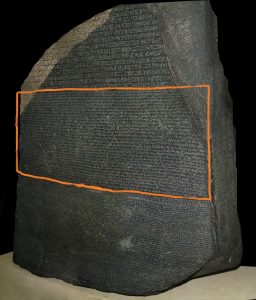II. Characteristics of Demotic
Demotic designates a script as well as a stage of the Egyptian language which was in use from the seventh century BCE to the fifth century CE. In Egyptian itself, Demotic was characterized as the 'script of the letter' in contrast to the hieroglyphs referred to as 'word of god'. The term 'Demotic' itself goes back to the Greek historian Herodotus (Hdt. 2.36) who called the script dēmotika ('for the people' or 'in common use'), while he also described the hieroglyphs as a divine or hallowed script (hīra). This opposition of a script for secular purposes and one for divine texts is certainly true for the initial phase of Demotic when it was used for documentary purposes only. Later on, also literary and religious texts were written in Demotic. The importance of this script may be illustrated by the fact that the Rosetta Stone was, additionally to Egyptian hieroglyphs and Greek, also inscribed in Demotic. This part is by chance also the best preserved of this sacerdotal decree (see below).

Demotic was written from right to left which was also the preferred writing direction for Egyptian in general. Texts in Demotic are mostly found on papyrus and ostraca (sherds of ceramics), but also graffiti or engravings are possible. The script developed from Hieratic which was the other cursive script of Egyptian and based on cursive, simplified hierogylphs. It was first used in the third millenium BCE and was still in use parallel to Demotic. Contrary to Hieratic, for which it is customary to produce a hieroglyphic transcript, Demotic also developed forms of its own which cannot be traced back to hieroglyphic origins. Therefore, scholars traditionally only respresent Demotic in transliteration.
The Demotic sign inventory consists of phonetic signs as well as determinatives which represented the general idea of a word. A main difficulty of Demotic is rooted in so-called ligatures, i. e. different signs that are connected by the scribe and coalesced over time. The result of this process are signs that are hardy retraceable to their original forms. Matters are further complicated by regional differences as certain ligatures only arose in certain areas or in a certain writing school in Egypt. Furthermore, diachronic changes in writing have to be taken into account. Lastly, also a scribe's own handwriting can complicate matters as we can still observe today.
An instructive case study of writing differences can be seen here with the noun anch meaning 'life' in Demotic (and also Egyptian) presented by the Demotic Palaeographical Database Project (DPDP).